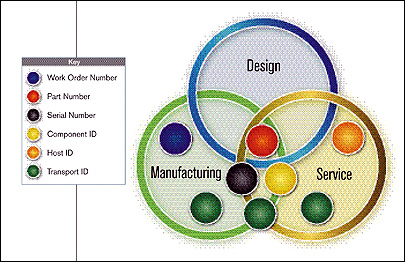Should you replace a circuit board on a photocopier or repair a TV under warranty? These decisions are dependent on the ability to gather suitable information about the state of the product—and the answer changes as the life cycle of the product evolves. The collection of comprehensive life-cycle information is critical to product lifecycle management (PLM)—the management and optimization of the processes involved in the duration of a product from its conception to retirement.
But consider the typical situation today: A manufactured part can have a multitude of serial numbers over its existence; data associated with these serial numbers is even more broadly distributed; and access to that data is dependent on myriad permissions, access paths and security constraints.
|
|
The EPCglobal Network, as well as other strategies for using RFID to link physical products to networked databases of product information, has provided a mechanism that enables simple access to product information via a tag on-board the product. RFID-based network strategies are especially well suited for accessing the history of complex products.
A common serial number or ID is the key to managing the myriad data sources that contain information about a product through its life. To understand the challenges of managing this data without a common ID, consider a recent study conducted with a computer-systems manufacturer, which examined the complexity of accessing product data. The diagram indicates the many different IDs for a single line replaceable unit and the range of databases required to store different types of data about that product. A single path to accessing all this data is the PLM “holy grail” for RFID.
At the Cambridge Auto-ID Lab, three projects address different aspects of PLM. In PROMISE—Product Lifecycle Management and Information Tracking Using Smart Embedded Systems—an architecture is being developed as a blueprint for linking smart devices to product databases. In BRIDGE—Building Radio Frequency IDentification
Solutions for the Global Environment—the EPCglobal Network is being extended to support product information in application environments, such as electronic goods warranty management, returns and repairs. And the Aerospace ID Programme is studying the maintenance and repair of aero components throughout their lifespan.
In the future, the Keio, MIT and Cambridge Auto-ID Labs will examine fundamental questions about whether today’s information environments, such as Enterprise Requirement Planning systems, can support life-cycle product information, or whether revolutionary new information architectures are needed to complement the many changes that have been introduced through RFID.
Duncan McFarlane is director of the Cambridge Auto-ID Lab and research director of the Aerospace ID Programme.



